Improving Conflict Management Skills in Diverse Workplaces
VerifiedAdded on 2023/04/26
|15
|3551
|211
Report
AI Summary
This report reflects on two conflict management experiences in a diverse, international company setting. The first experience involved resolving a conflict between a labor union and an architect, where effective communication and negotiation skills, aligned with an ESTP personality type according to the MBTI model, led to a successful resolution. The second experience involved managing a cross-cultural team where conflicts arose due to cultural differences; the dominant behavioral style, as analyzed by the DISC model, proved ineffective. The report also incorporates the 'I statement' concept for conflict resolution and transactional analysis to understand ego states. The Johari Window model is used for self-development, and a self-development plan for conflict management is proposed. The conclusion emphasizes the importance of empathy and adaptability in managing conflicts within diverse work environments, highlighting the need for continuous self-improvement and learning from past experiences, with Desklib providing a platform for accessing similar solved assignments and study tools.
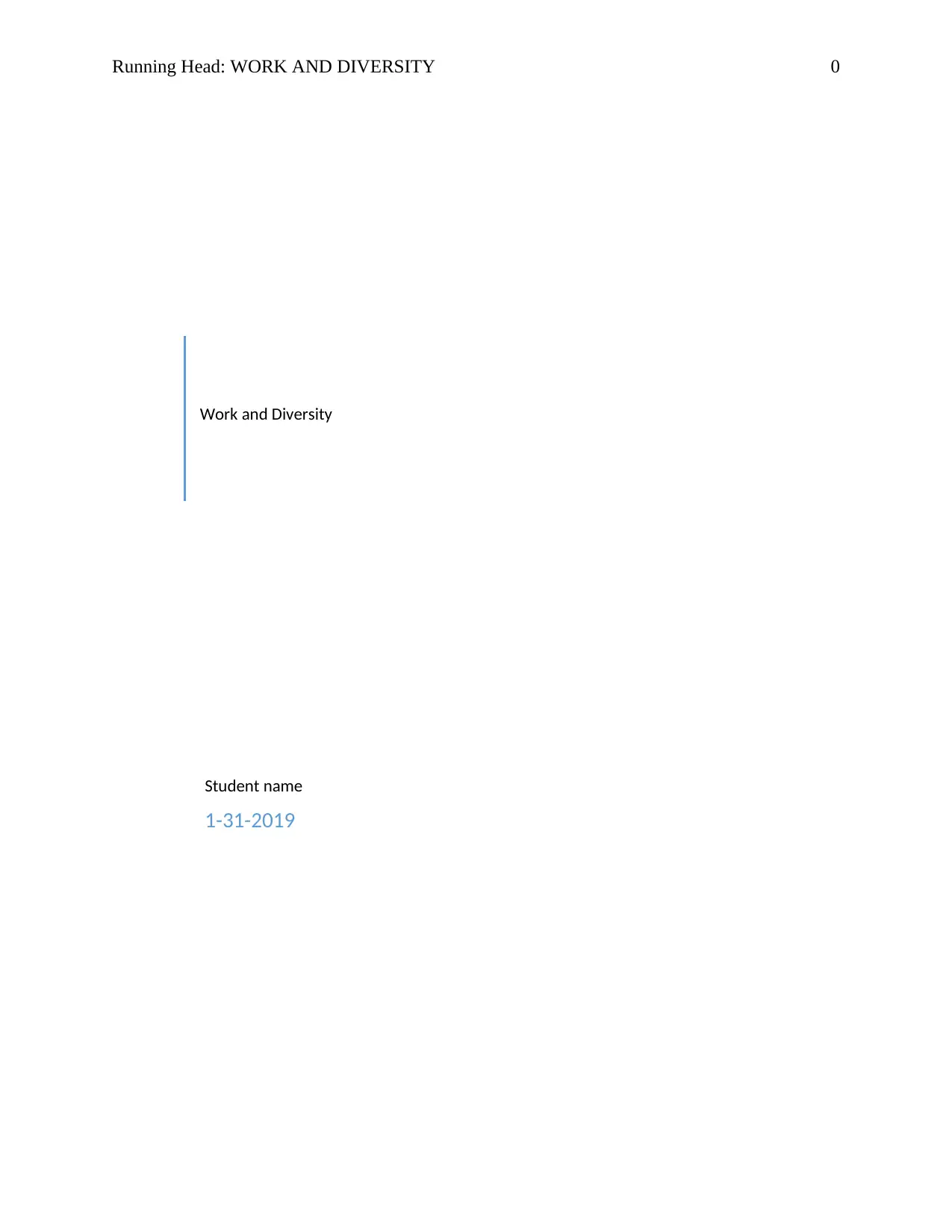
Running Head: WORK AND DIVERSITY 0
Work and Diversity
Student name
1-31-2019
Work and Diversity
Student name
1-31-2019
Paraphrase This Document
Need a fresh take? Get an instant paraphrase of this document with our AI Paraphraser
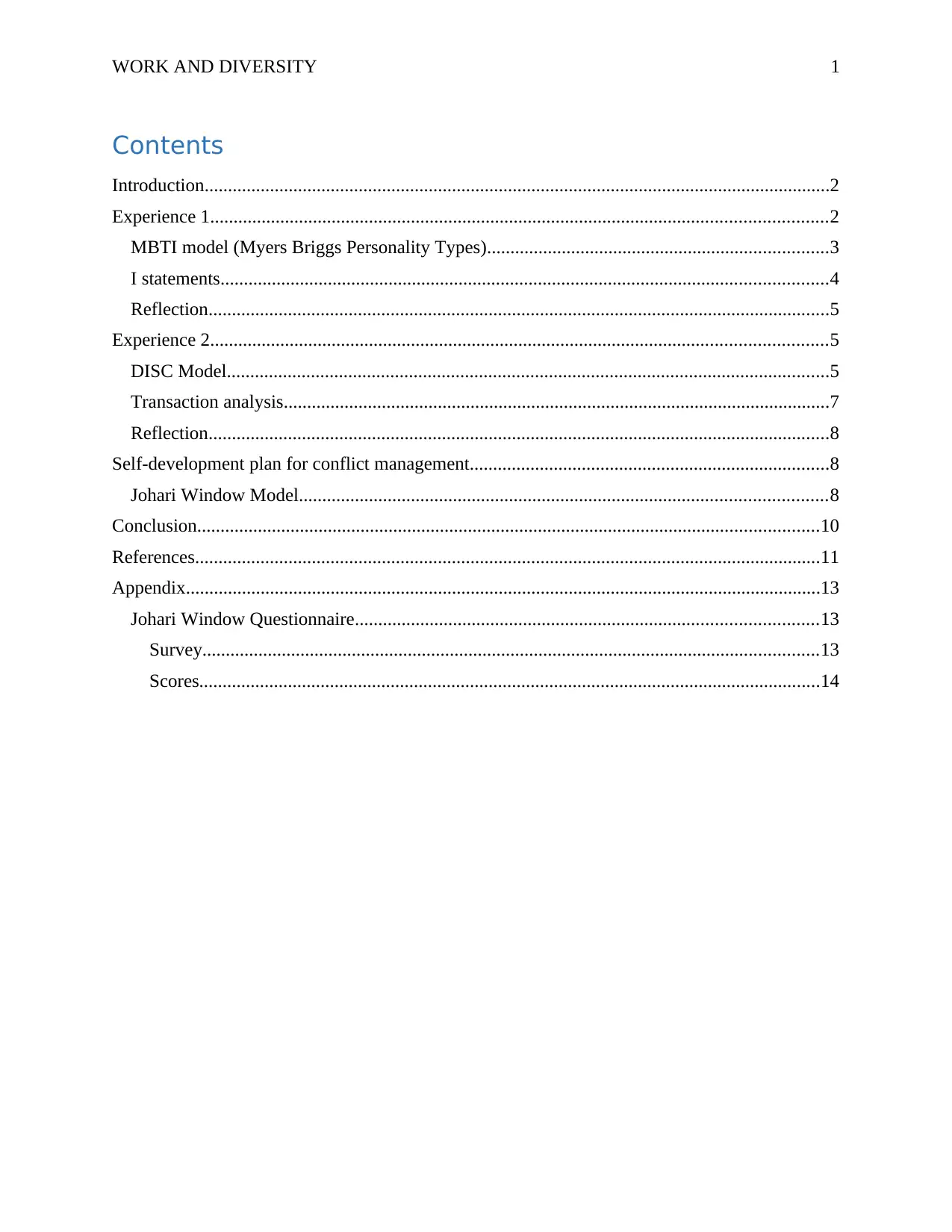
WORK AND DIVERSITY 1
Contents
Introduction......................................................................................................................................2
Experience 1....................................................................................................................................2
MBTI model (Myers Briggs Personality Types).........................................................................3
I statements..................................................................................................................................4
Reflection.....................................................................................................................................5
Experience 2....................................................................................................................................5
DISC Model.................................................................................................................................5
Transaction analysis.....................................................................................................................7
Reflection.....................................................................................................................................8
Self-development plan for conflict management.............................................................................8
Johari Window Model.................................................................................................................8
Conclusion.....................................................................................................................................10
References......................................................................................................................................11
Appendix........................................................................................................................................13
Johari Window Questionnaire...................................................................................................13
Survey....................................................................................................................................13
Scores.....................................................................................................................................14
Contents
Introduction......................................................................................................................................2
Experience 1....................................................................................................................................2
MBTI model (Myers Briggs Personality Types).........................................................................3
I statements..................................................................................................................................4
Reflection.....................................................................................................................................5
Experience 2....................................................................................................................................5
DISC Model.................................................................................................................................5
Transaction analysis.....................................................................................................................7
Reflection.....................................................................................................................................8
Self-development plan for conflict management.............................................................................8
Johari Window Model.................................................................................................................8
Conclusion.....................................................................................................................................10
References......................................................................................................................................11
Appendix........................................................................................................................................13
Johari Window Questionnaire...................................................................................................13
Survey....................................................................................................................................13
Scores.....................................................................................................................................14
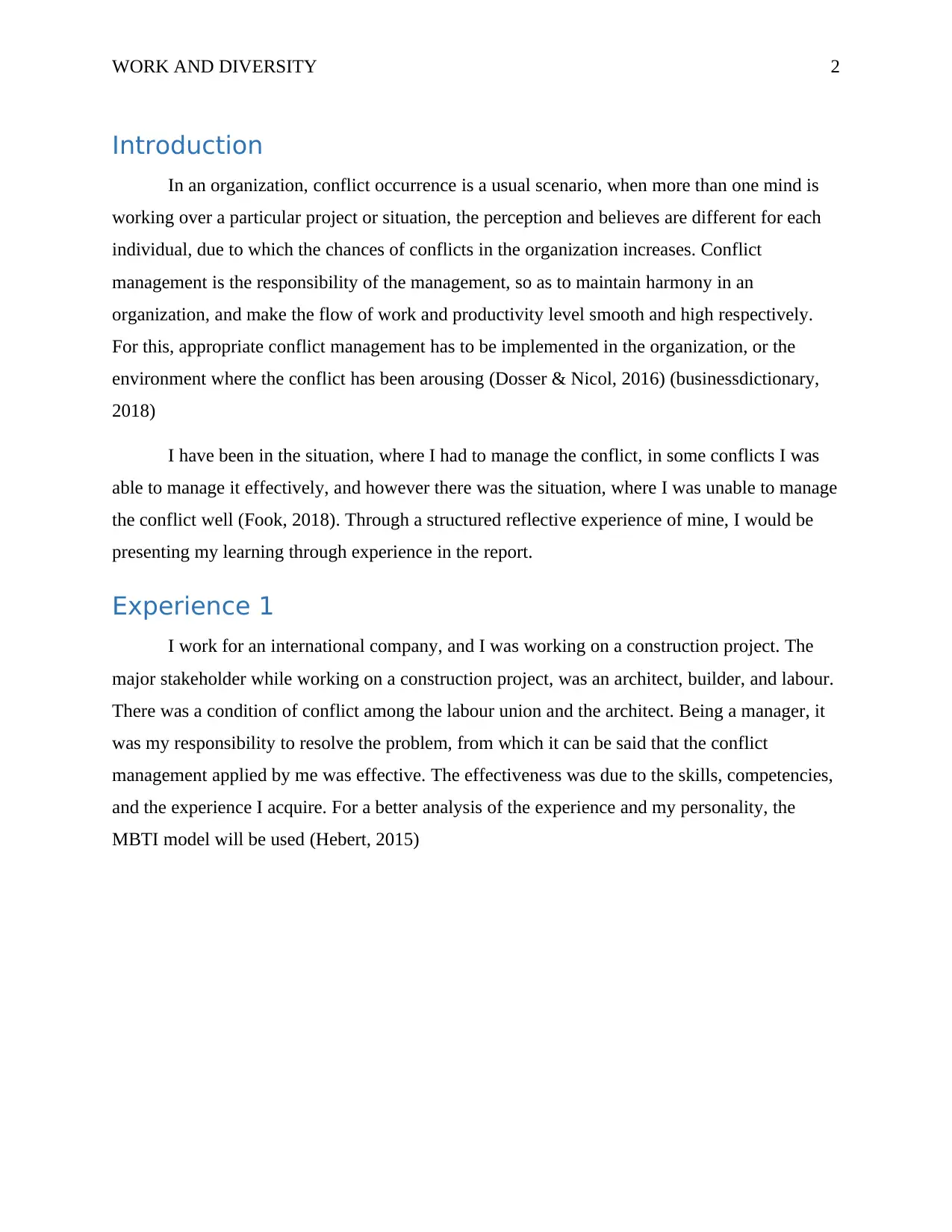
WORK AND DIVERSITY 2
Introduction
In an organization, conflict occurrence is a usual scenario, when more than one mind is
working over a particular project or situation, the perception and believes are different for each
individual, due to which the chances of conflicts in the organization increases. Conflict
management is the responsibility of the management, so as to maintain harmony in an
organization, and make the flow of work and productivity level smooth and high respectively.
For this, appropriate conflict management has to be implemented in the organization, or the
environment where the conflict has been arousing (Dosser & Nicol, 2016) (businessdictionary,
2018)
I have been in the situation, where I had to manage the conflict, in some conflicts I was
able to manage it effectively, and however there was the situation, where I was unable to manage
the conflict well (Fook, 2018). Through a structured reflective experience of mine, I would be
presenting my learning through experience in the report.
Experience 1
I work for an international company, and I was working on a construction project. The
major stakeholder while working on a construction project, was an architect, builder, and labour.
There was a condition of conflict among the labour union and the architect. Being a manager, it
was my responsibility to resolve the problem, from which it can be said that the conflict
management applied by me was effective. The effectiveness was due to the skills, competencies,
and the experience I acquire. For a better analysis of the experience and my personality, the
MBTI model will be used (Hebert, 2015)
Introduction
In an organization, conflict occurrence is a usual scenario, when more than one mind is
working over a particular project or situation, the perception and believes are different for each
individual, due to which the chances of conflicts in the organization increases. Conflict
management is the responsibility of the management, so as to maintain harmony in an
organization, and make the flow of work and productivity level smooth and high respectively.
For this, appropriate conflict management has to be implemented in the organization, or the
environment where the conflict has been arousing (Dosser & Nicol, 2016) (businessdictionary,
2018)
I have been in the situation, where I had to manage the conflict, in some conflicts I was
able to manage it effectively, and however there was the situation, where I was unable to manage
the conflict well (Fook, 2018). Through a structured reflective experience of mine, I would be
presenting my learning through experience in the report.
Experience 1
I work for an international company, and I was working on a construction project. The
major stakeholder while working on a construction project, was an architect, builder, and labour.
There was a condition of conflict among the labour union and the architect. Being a manager, it
was my responsibility to resolve the problem, from which it can be said that the conflict
management applied by me was effective. The effectiveness was due to the skills, competencies,
and the experience I acquire. For a better analysis of the experience and my personality, the
MBTI model will be used (Hebert, 2015)
⊘ This is a preview!⊘
Do you want full access?
Subscribe today to unlock all pages.

Trusted by 1+ million students worldwide

WORK AND DIVERSITY 3
MBTI model (Myers Briggs Personality Types)
Figure 1:( Source: (Ismail & Basharirad, 2017)
This model is helpful in analysing the personality, which could be the reason for better
conflict management in this situation. There are 16 personality types according to this model,
and it can be analysed by answering four major questions (Ismail & Basharirad, 2017)
The first question is that Am I inwardly focused or outwardly focused person, on which
two relevant aspect is found that is extraversion (E) in case of outwardly focused, and
introversion (I) in case of an inwardly focused person.
The second question would be the way I would prefer to get the information, the two
options for this is sensing (S), that is focusing over facts and figures while understanding
and collecting relevant information, and other is intuition (N) that is taking information in
form of objective logic, thinking, believes, and on feelings.
The third question is the preferable decision-making style, this ends up with two option
based on the answer, that is thinking (T) that is taking decisions through the detached
approach and analytically. Another is feeling (F) that is preferred is given on feeling and
believes while making decisions.
MBTI model (Myers Briggs Personality Types)
Figure 1:( Source: (Ismail & Basharirad, 2017)
This model is helpful in analysing the personality, which could be the reason for better
conflict management in this situation. There are 16 personality types according to this model,
and it can be analysed by answering four major questions (Ismail & Basharirad, 2017)
The first question is that Am I inwardly focused or outwardly focused person, on which
two relevant aspect is found that is extraversion (E) in case of outwardly focused, and
introversion (I) in case of an inwardly focused person.
The second question would be the way I would prefer to get the information, the two
options for this is sensing (S), that is focusing over facts and figures while understanding
and collecting relevant information, and other is intuition (N) that is taking information in
form of objective logic, thinking, believes, and on feelings.
The third question is the preferable decision-making style, this ends up with two option
based on the answer, that is thinking (T) that is taking decisions through the detached
approach and analytically. Another is feeling (F) that is preferred is given on feeling and
believes while making decisions.
Paraphrase This Document
Need a fresh take? Get an instant paraphrase of this document with our AI Paraphraser
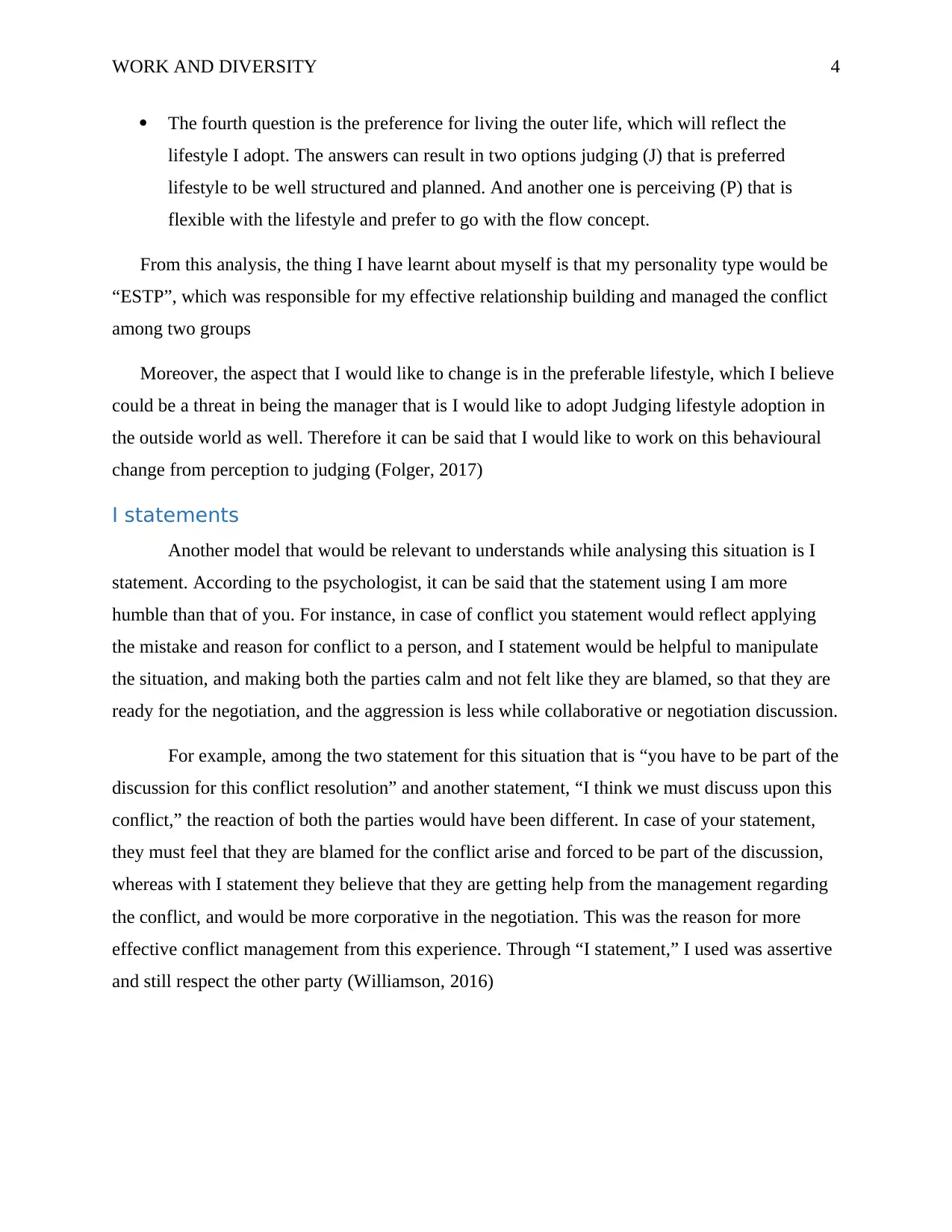
WORK AND DIVERSITY 4
The fourth question is the preference for living the outer life, which will reflect the
lifestyle I adopt. The answers can result in two options judging (J) that is preferred
lifestyle to be well structured and planned. And another one is perceiving (P) that is
flexible with the lifestyle and prefer to go with the flow concept.
From this analysis, the thing I have learnt about myself is that my personality type would be
“ESTP”, which was responsible for my effective relationship building and managed the conflict
among two groups
Moreover, the aspect that I would like to change is in the preferable lifestyle, which I believe
could be a threat in being the manager that is I would like to adopt Judging lifestyle adoption in
the outside world as well. Therefore it can be said that I would like to work on this behavioural
change from perception to judging (Folger, 2017)
I statements
Another model that would be relevant to understands while analysing this situation is I
statement. According to the psychologist, it can be said that the statement using I am more
humble than that of you. For instance, in case of conflict you statement would reflect applying
the mistake and reason for conflict to a person, and I statement would be helpful to manipulate
the situation, and making both the parties calm and not felt like they are blamed, so that they are
ready for the negotiation, and the aggression is less while collaborative or negotiation discussion.
For example, among the two statement for this situation that is “you have to be part of the
discussion for this conflict resolution” and another statement, “I think we must discuss upon this
conflict,” the reaction of both the parties would have been different. In case of your statement,
they must feel that they are blamed for the conflict arise and forced to be part of the discussion,
whereas with I statement they believe that they are getting help from the management regarding
the conflict, and would be more corporative in the negotiation. This was the reason for more
effective conflict management from this experience. Through “I statement,” I used was assertive
and still respect the other party (Williamson, 2016)
The fourth question is the preference for living the outer life, which will reflect the
lifestyle I adopt. The answers can result in two options judging (J) that is preferred
lifestyle to be well structured and planned. And another one is perceiving (P) that is
flexible with the lifestyle and prefer to go with the flow concept.
From this analysis, the thing I have learnt about myself is that my personality type would be
“ESTP”, which was responsible for my effective relationship building and managed the conflict
among two groups
Moreover, the aspect that I would like to change is in the preferable lifestyle, which I believe
could be a threat in being the manager that is I would like to adopt Judging lifestyle adoption in
the outside world as well. Therefore it can be said that I would like to work on this behavioural
change from perception to judging (Folger, 2017)
I statements
Another model that would be relevant to understands while analysing this situation is I
statement. According to the psychologist, it can be said that the statement using I am more
humble than that of you. For instance, in case of conflict you statement would reflect applying
the mistake and reason for conflict to a person, and I statement would be helpful to manipulate
the situation, and making both the parties calm and not felt like they are blamed, so that they are
ready for the negotiation, and the aggression is less while collaborative or negotiation discussion.
For example, among the two statement for this situation that is “you have to be part of the
discussion for this conflict resolution” and another statement, “I think we must discuss upon this
conflict,” the reaction of both the parties would have been different. In case of your statement,
they must feel that they are blamed for the conflict arise and forced to be part of the discussion,
whereas with I statement they believe that they are getting help from the management regarding
the conflict, and would be more corporative in the negotiation. This was the reason for more
effective conflict management from this experience. Through “I statement,” I used was assertive
and still respect the other party (Williamson, 2016)
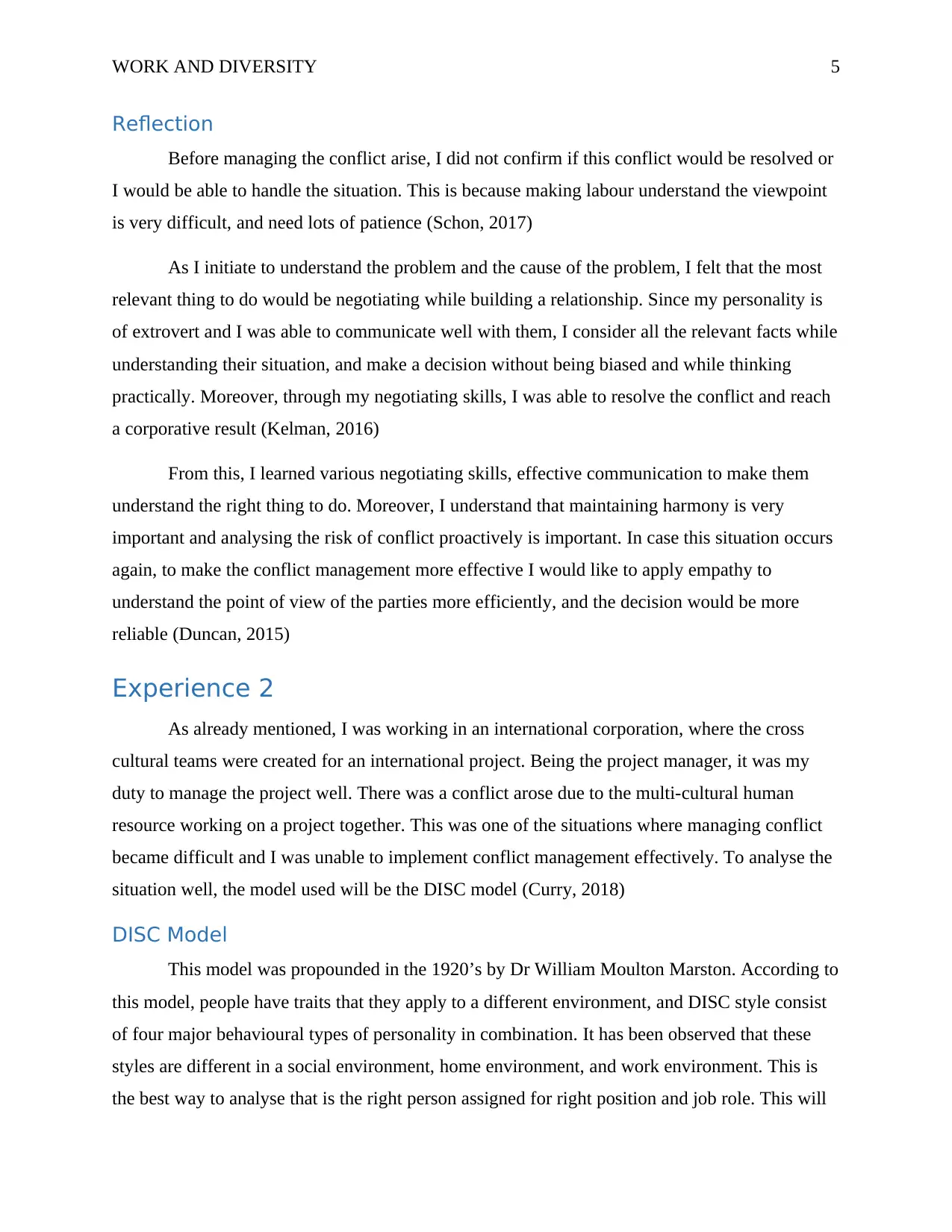
WORK AND DIVERSITY 5
Reflection
Before managing the conflict arise, I did not confirm if this conflict would be resolved or
I would be able to handle the situation. This is because making labour understand the viewpoint
is very difficult, and need lots of patience (Schon, 2017)
As I initiate to understand the problem and the cause of the problem, I felt that the most
relevant thing to do would be negotiating while building a relationship. Since my personality is
of extrovert and I was able to communicate well with them, I consider all the relevant facts while
understanding their situation, and make a decision without being biased and while thinking
practically. Moreover, through my negotiating skills, I was able to resolve the conflict and reach
a corporative result (Kelman, 2016)
From this, I learned various negotiating skills, effective communication to make them
understand the right thing to do. Moreover, I understand that maintaining harmony is very
important and analysing the risk of conflict proactively is important. In case this situation occurs
again, to make the conflict management more effective I would like to apply empathy to
understand the point of view of the parties more efficiently, and the decision would be more
reliable (Duncan, 2015)
Experience 2
As already mentioned, I was working in an international corporation, where the cross
cultural teams were created for an international project. Being the project manager, it was my
duty to manage the project well. There was a conflict arose due to the multi-cultural human
resource working on a project together. This was one of the situations where managing conflict
became difficult and I was unable to implement conflict management effectively. To analyse the
situation well, the model used will be the DISC model (Curry, 2018)
DISC Model
This model was propounded in the 1920’s by Dr William Moulton Marston. According to
this model, people have traits that they apply to a different environment, and DISC style consist
of four major behavioural types of personality in combination. It has been observed that these
styles are different in a social environment, home environment, and work environment. This is
the best way to analyse that is the right person assigned for right position and job role. This will
Reflection
Before managing the conflict arise, I did not confirm if this conflict would be resolved or
I would be able to handle the situation. This is because making labour understand the viewpoint
is very difficult, and need lots of patience (Schon, 2017)
As I initiate to understand the problem and the cause of the problem, I felt that the most
relevant thing to do would be negotiating while building a relationship. Since my personality is
of extrovert and I was able to communicate well with them, I consider all the relevant facts while
understanding their situation, and make a decision without being biased and while thinking
practically. Moreover, through my negotiating skills, I was able to resolve the conflict and reach
a corporative result (Kelman, 2016)
From this, I learned various negotiating skills, effective communication to make them
understand the right thing to do. Moreover, I understand that maintaining harmony is very
important and analysing the risk of conflict proactively is important. In case this situation occurs
again, to make the conflict management more effective I would like to apply empathy to
understand the point of view of the parties more efficiently, and the decision would be more
reliable (Duncan, 2015)
Experience 2
As already mentioned, I was working in an international corporation, where the cross
cultural teams were created for an international project. Being the project manager, it was my
duty to manage the project well. There was a conflict arose due to the multi-cultural human
resource working on a project together. This was one of the situations where managing conflict
became difficult and I was unable to implement conflict management effectively. To analyse the
situation well, the model used will be the DISC model (Curry, 2018)
DISC Model
This model was propounded in the 1920’s by Dr William Moulton Marston. According to
this model, people have traits that they apply to a different environment, and DISC style consist
of four major behavioural types of personality in combination. It has been observed that these
styles are different in a social environment, home environment, and work environment. This is
the best way to analyse that is the right person assigned for right position and job role. This will
⊘ This is a preview!⊘
Do you want full access?
Subscribe today to unlock all pages.

Trusted by 1+ million students worldwide

WORK AND DIVERSITY 6
make understand the individual fears, behaviour and communication tendencies, and needs. This
model could be helpful in understanding the improvement scope for an individual (Creech &
Maguire, 2015).
Figure 2:( Source: (Creech & Maguire, 2015)
For instance, to analyse my experience in conflict management:
1. D- dominant – this is the quadrant, where the people are task focused and extrovert. This
could have work done through force. The major characteristics associated with this
personality includes decisive, direct, problem solver, self-starter, high ego strength, and
risk taker. This personality individual is the innovative one in the team and led others
towards the same. The possible weakness according to this personality is disliked routine,
argumentative attitude and overstep authority
2. I- influence – according to this quadrant, individual are more people focused than the
result focused. The characteristics that are observed through this personality is trusting
team members, optimistic, enthusiastic, talkative, emotional, and impulsive. The major
make understand the individual fears, behaviour and communication tendencies, and needs. This
model could be helpful in understanding the improvement scope for an individual (Creech &
Maguire, 2015).
Figure 2:( Source: (Creech & Maguire, 2015)
For instance, to analyse my experience in conflict management:
1. D- dominant – this is the quadrant, where the people are task focused and extrovert. This
could have work done through force. The major characteristics associated with this
personality includes decisive, direct, problem solver, self-starter, high ego strength, and
risk taker. This personality individual is the innovative one in the team and led others
towards the same. The possible weakness according to this personality is disliked routine,
argumentative attitude and overstep authority
2. I- influence – according to this quadrant, individual are more people focused than the
result focused. The characteristics that are observed through this personality is trusting
team members, optimistic, enthusiastic, talkative, emotional, and impulsive. The major
Paraphrase This Document
Need a fresh take? Get an instant paraphrase of this document with our AI Paraphraser
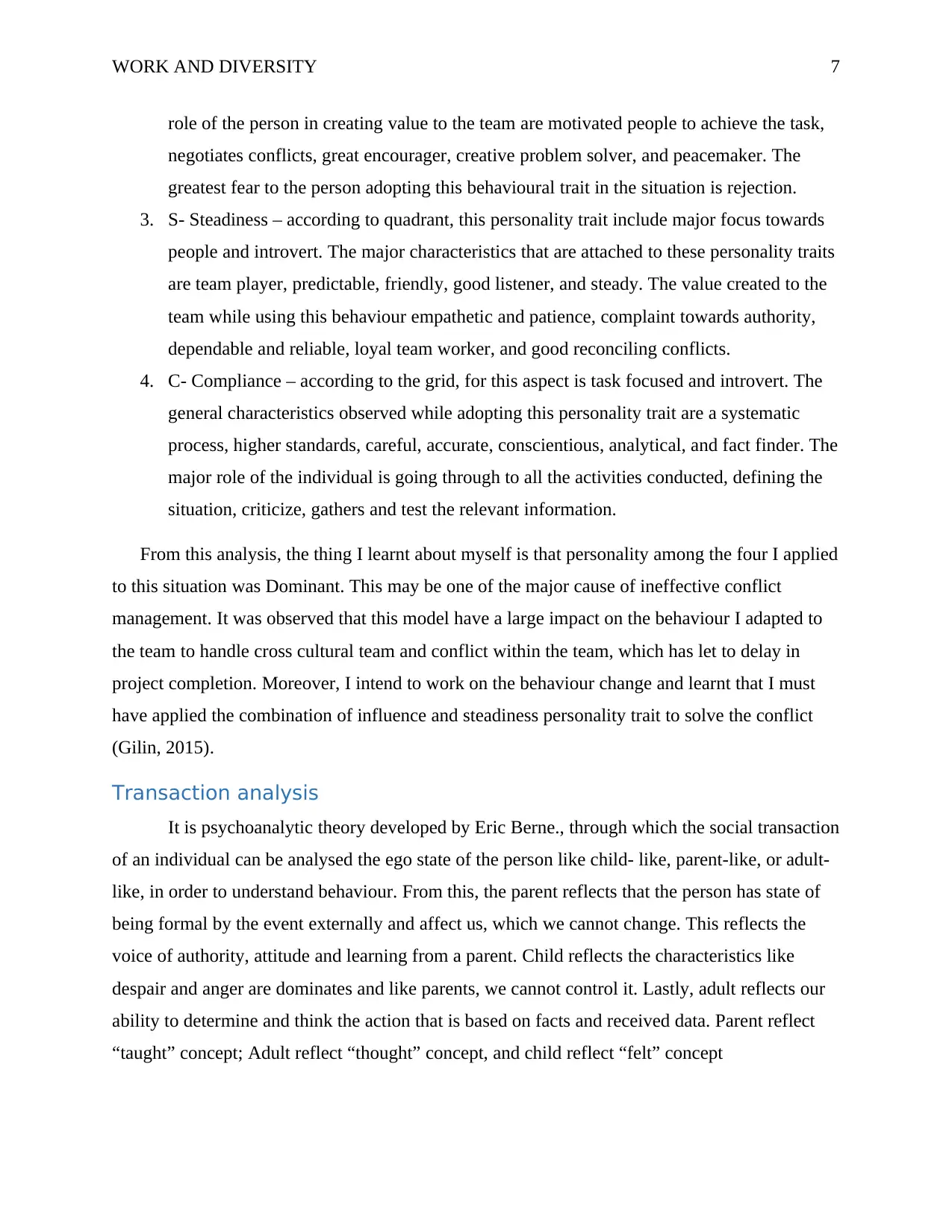
WORK AND DIVERSITY 7
role of the person in creating value to the team are motivated people to achieve the task,
negotiates conflicts, great encourager, creative problem solver, and peacemaker. The
greatest fear to the person adopting this behavioural trait in the situation is rejection.
3. S- Steadiness – according to quadrant, this personality trait include major focus towards
people and introvert. The major characteristics that are attached to these personality traits
are team player, predictable, friendly, good listener, and steady. The value created to the
team while using this behaviour empathetic and patience, complaint towards authority,
dependable and reliable, loyal team worker, and good reconciling conflicts.
4. C- Compliance – according to the grid, for this aspect is task focused and introvert. The
general characteristics observed while adopting this personality trait are a systematic
process, higher standards, careful, accurate, conscientious, analytical, and fact finder. The
major role of the individual is going through to all the activities conducted, defining the
situation, criticize, gathers and test the relevant information.
From this analysis, the thing I learnt about myself is that personality among the four I applied
to this situation was Dominant. This may be one of the major cause of ineffective conflict
management. It was observed that this model have a large impact on the behaviour I adapted to
the team to handle cross cultural team and conflict within the team, which has let to delay in
project completion. Moreover, I intend to work on the behaviour change and learnt that I must
have applied the combination of influence and steadiness personality trait to solve the conflict
(Gilin, 2015).
Transaction analysis
It is psychoanalytic theory developed by Eric Berne., through which the social transaction
of an individual can be analysed the ego state of the person like child- like, parent-like, or adult-
like, in order to understand behaviour. From this, the parent reflects that the person has state of
being formal by the event externally and affect us, which we cannot change. This reflects the
voice of authority, attitude and learning from a parent. Child reflects the characteristics like
despair and anger are dominates and like parents, we cannot control it. Lastly, adult reflects our
ability to determine and think the action that is based on facts and received data. Parent reflect
“taught” concept; Adult reflect “thought” concept, and child reflect “felt” concept
role of the person in creating value to the team are motivated people to achieve the task,
negotiates conflicts, great encourager, creative problem solver, and peacemaker. The
greatest fear to the person adopting this behavioural trait in the situation is rejection.
3. S- Steadiness – according to quadrant, this personality trait include major focus towards
people and introvert. The major characteristics that are attached to these personality traits
are team player, predictable, friendly, good listener, and steady. The value created to the
team while using this behaviour empathetic and patience, complaint towards authority,
dependable and reliable, loyal team worker, and good reconciling conflicts.
4. C- Compliance – according to the grid, for this aspect is task focused and introvert. The
general characteristics observed while adopting this personality trait are a systematic
process, higher standards, careful, accurate, conscientious, analytical, and fact finder. The
major role of the individual is going through to all the activities conducted, defining the
situation, criticize, gathers and test the relevant information.
From this analysis, the thing I learnt about myself is that personality among the four I applied
to this situation was Dominant. This may be one of the major cause of ineffective conflict
management. It was observed that this model have a large impact on the behaviour I adapted to
the team to handle cross cultural team and conflict within the team, which has let to delay in
project completion. Moreover, I intend to work on the behaviour change and learnt that I must
have applied the combination of influence and steadiness personality trait to solve the conflict
(Gilin, 2015).
Transaction analysis
It is psychoanalytic theory developed by Eric Berne., through which the social transaction
of an individual can be analysed the ego state of the person like child- like, parent-like, or adult-
like, in order to understand behaviour. From this, the parent reflects that the person has state of
being formal by the event externally and affect us, which we cannot change. This reflects the
voice of authority, attitude and learning from a parent. Child reflects the characteristics like
despair and anger are dominates and like parents, we cannot control it. Lastly, adult reflects our
ability to determine and think the action that is based on facts and received data. Parent reflect
“taught” concept; Adult reflect “thought” concept, and child reflect “felt” concept

WORK AND DIVERSITY 8
From this analysis, I learnt about myself that I am a parent person, which has impacted
more authoritative behaviour in this conflict management, which result in ineffective conflict
management. I would prefer to be a child and understand people more if this situation occurs
again (ericberne, 2019)
Reflection
Before this experience, I was confident enough to have leadership capabilities, and I not
aware that the conflict would be so bad that this could have a very negative consequence. I
thought I will be able to manage the conflict effectively.
As I initiated to attempt managing the conflict, and I used the dominant behavioural style
in this situation, as the major focus was to accomplish the project, I realised that the situation is
not getting into control. After a large span of time, the conflict was resolved, and but till then the
project was already delayed according to the schedule (University, 2018)
After the experience, I realized that I could have been more people focused while
applying conflict management and the management could have been more effective. Moreover,
the major learning from the experience was, the relevance of time management, effective
communication use, and attitude towards team members. In case this situation occurs again, I
would like to adapt the combination of influence and steadiness behaviour style to solve the
conflict, as per DISC styles of personality (Hillman, 2014)
Self-development plan for conflict management
Johari Window Model
The first model that is used to analyse before developing a plan. This is the model, which
is helpful in self-awareness that is understanding yourself, and mutual understanding among
individuals in a team or group. The model was propounded in 1955 by Hary Ingham and Joseph
Luft, the psychologists. It is based on feedback from oneself and others, and a survey is
conducted (Luft & Ingham, 2013).
From the results of the survey as attached in the appendix, the points in the Johari
window model, as per my personality are presented below:
From this analysis, I learnt about myself that I am a parent person, which has impacted
more authoritative behaviour in this conflict management, which result in ineffective conflict
management. I would prefer to be a child and understand people more if this situation occurs
again (ericberne, 2019)
Reflection
Before this experience, I was confident enough to have leadership capabilities, and I not
aware that the conflict would be so bad that this could have a very negative consequence. I
thought I will be able to manage the conflict effectively.
As I initiated to attempt managing the conflict, and I used the dominant behavioural style
in this situation, as the major focus was to accomplish the project, I realised that the situation is
not getting into control. After a large span of time, the conflict was resolved, and but till then the
project was already delayed according to the schedule (University, 2018)
After the experience, I realized that I could have been more people focused while
applying conflict management and the management could have been more effective. Moreover,
the major learning from the experience was, the relevance of time management, effective
communication use, and attitude towards team members. In case this situation occurs again, I
would like to adapt the combination of influence and steadiness behaviour style to solve the
conflict, as per DISC styles of personality (Hillman, 2014)
Self-development plan for conflict management
Johari Window Model
The first model that is used to analyse before developing a plan. This is the model, which
is helpful in self-awareness that is understanding yourself, and mutual understanding among
individuals in a team or group. The model was propounded in 1955 by Hary Ingham and Joseph
Luft, the psychologists. It is based on feedback from oneself and others, and a survey is
conducted (Luft & Ingham, 2013).
From the results of the survey as attached in the appendix, the points in the Johari
window model, as per my personality are presented below:
⊘ This is a preview!⊘
Do you want full access?
Subscribe today to unlock all pages.

Trusted by 1+ million students worldwide
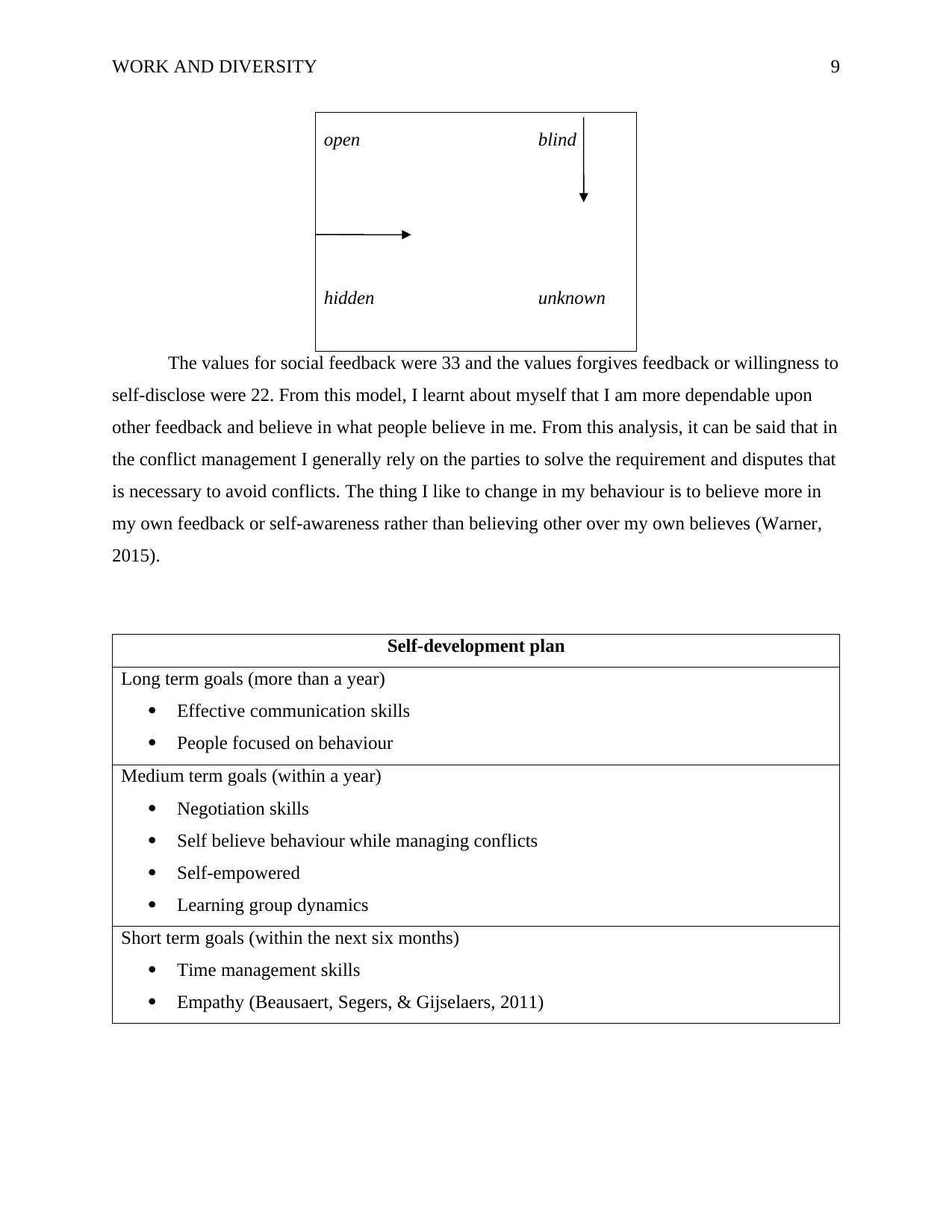
WORK AND DIVERSITY 9
open blind
hidden unknown
The values for social feedback were 33 and the values forgives feedback or willingness to
self-disclose were 22. From this model, I learnt about myself that I am more dependable upon
other feedback and believe in what people believe in me. From this analysis, it can be said that in
the conflict management I generally rely on the parties to solve the requirement and disputes that
is necessary to avoid conflicts. The thing I like to change in my behaviour is to believe more in
my own feedback or self-awareness rather than believing other over my own believes (Warner,
2015).
Self-development plan
Long term goals (more than a year)
Effective communication skills
People focused on behaviour
Medium term goals (within a year)
Negotiation skills
Self believe behaviour while managing conflicts
Self-empowered
Learning group dynamics
Short term goals (within the next six months)
Time management skills
Empathy (Beausaert, Segers, & Gijselaers, 2011)
open blind
hidden unknown
The values for social feedback were 33 and the values forgives feedback or willingness to
self-disclose were 22. From this model, I learnt about myself that I am more dependable upon
other feedback and believe in what people believe in me. From this analysis, it can be said that in
the conflict management I generally rely on the parties to solve the requirement and disputes that
is necessary to avoid conflicts. The thing I like to change in my behaviour is to believe more in
my own feedback or self-awareness rather than believing other over my own believes (Warner,
2015).
Self-development plan
Long term goals (more than a year)
Effective communication skills
People focused on behaviour
Medium term goals (within a year)
Negotiation skills
Self believe behaviour while managing conflicts
Self-empowered
Learning group dynamics
Short term goals (within the next six months)
Time management skills
Empathy (Beausaert, Segers, & Gijselaers, 2011)
Paraphrase This Document
Need a fresh take? Get an instant paraphrase of this document with our AI Paraphraser
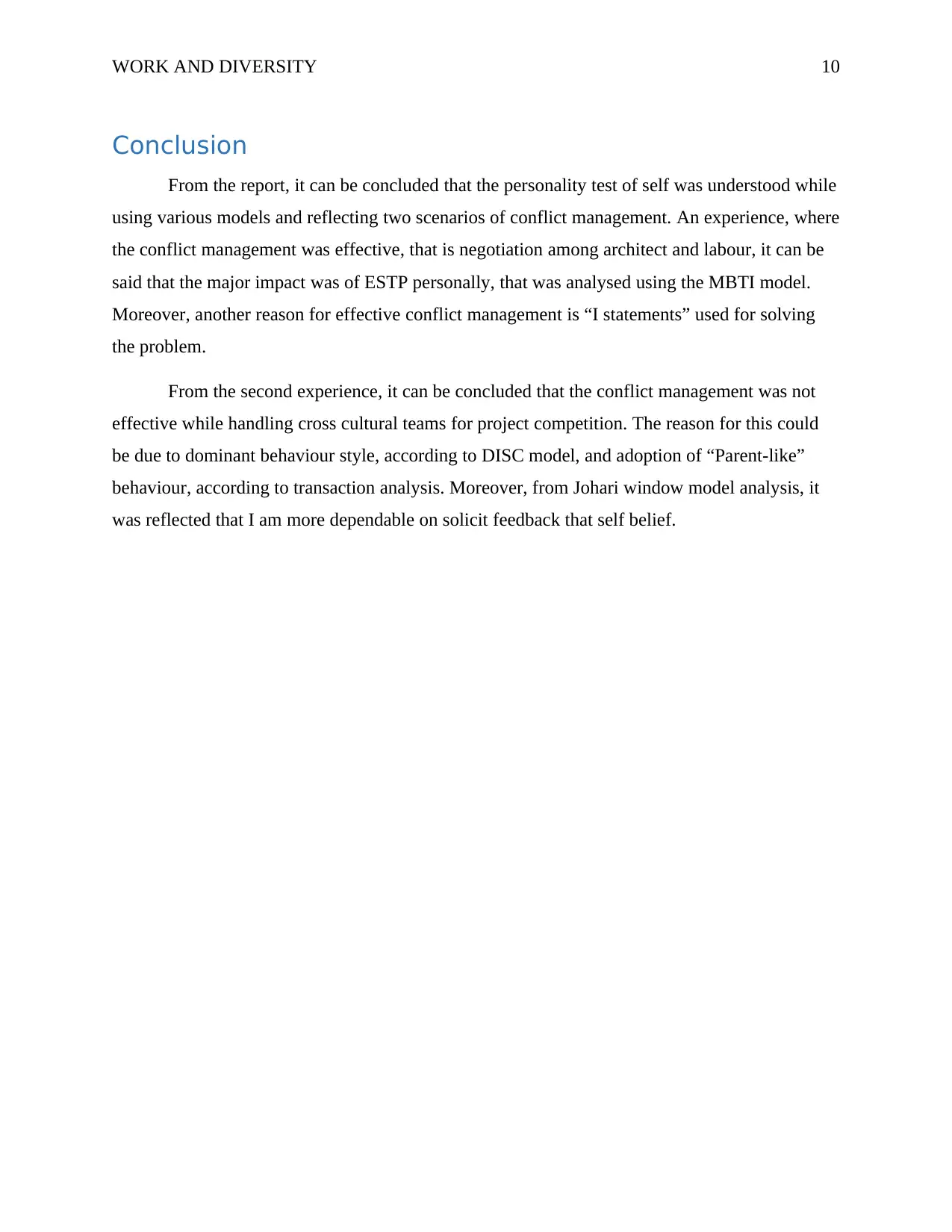
WORK AND DIVERSITY 10
Conclusion
From the report, it can be concluded that the personality test of self was understood while
using various models and reflecting two scenarios of conflict management. An experience, where
the conflict management was effective, that is negotiation among architect and labour, it can be
said that the major impact was of ESTP personally, that was analysed using the MBTI model.
Moreover, another reason for effective conflict management is “I statements” used for solving
the problem.
From the second experience, it can be concluded that the conflict management was not
effective while handling cross cultural teams for project competition. The reason for this could
be due to dominant behaviour style, according to DISC model, and adoption of “Parent-like”
behaviour, according to transaction analysis. Moreover, from Johari window model analysis, it
was reflected that I am more dependable on solicit feedback that self belief.
Conclusion
From the report, it can be concluded that the personality test of self was understood while
using various models and reflecting two scenarios of conflict management. An experience, where
the conflict management was effective, that is negotiation among architect and labour, it can be
said that the major impact was of ESTP personally, that was analysed using the MBTI model.
Moreover, another reason for effective conflict management is “I statements” used for solving
the problem.
From the second experience, it can be concluded that the conflict management was not
effective while handling cross cultural teams for project competition. The reason for this could
be due to dominant behaviour style, according to DISC model, and adoption of “Parent-like”
behaviour, according to transaction analysis. Moreover, from Johari window model analysis, it
was reflected that I am more dependable on solicit feedback that self belief.
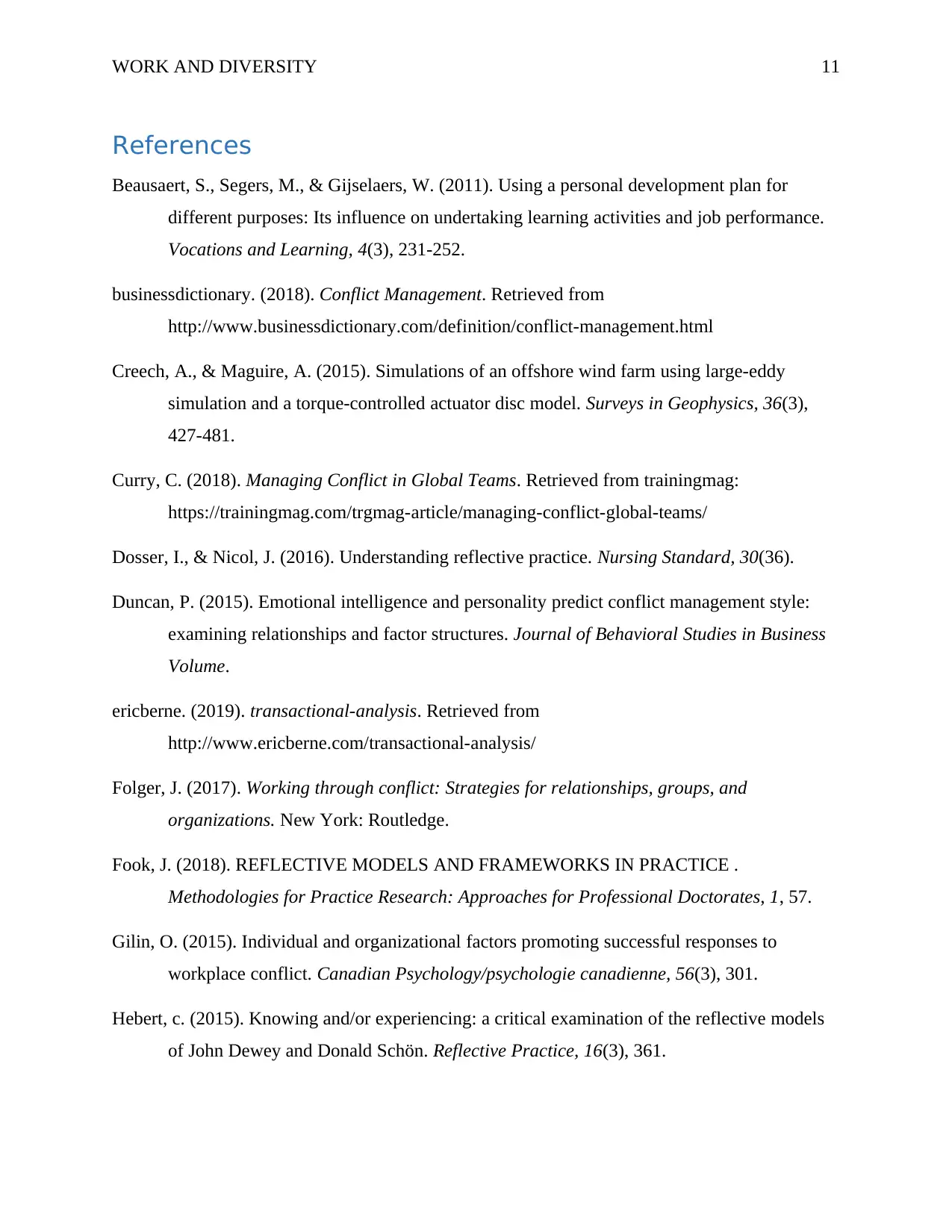
WORK AND DIVERSITY 11
References
Beausaert, S., Segers, M., & Gijselaers, W. (2011). Using a personal development plan for
different purposes: Its influence on undertaking learning activities and job performance.
Vocations and Learning, 4(3), 231-252.
businessdictionary. (2018). Conflict Management. Retrieved from
http://www.businessdictionary.com/definition/conflict-management.html
Creech, A., & Maguire, A. (2015). Simulations of an offshore wind farm using large-eddy
simulation and a torque-controlled actuator disc model. Surveys in Geophysics, 36(3),
427-481.
Curry, C. (2018). Managing Conflict in Global Teams. Retrieved from trainingmag:
https://trainingmag.com/trgmag-article/managing-conflict-global-teams/
Dosser, I., & Nicol, J. (2016). Understanding reflective practice. Nursing Standard, 30(36).
Duncan, P. (2015). Emotional intelligence and personality predict conflict management style:
examining relationships and factor structures. Journal of Behavioral Studies in Business
Volume.
ericberne. (2019). transactional-analysis. Retrieved from
http://www.ericberne.com/transactional-analysis/
Folger, J. (2017). Working through conflict: Strategies for relationships, groups, and
organizations. New York: Routledge.
Fook, J. (2018). REFLECTIVE MODELS AND FRAMEWORKS IN PRACTICE .
Methodologies for Practice Research: Approaches for Professional Doctorates, 1, 57.
Gilin, O. (2015). Individual and organizational factors promoting successful responses to
workplace conflict. Canadian Psychology/psychologie canadienne, 56(3), 301.
Hebert, c. (2015). Knowing and/or experiencing: a critical examination of the reflective models
of John Dewey and Donald Schön. Reflective Practice, 16(3), 361.
References
Beausaert, S., Segers, M., & Gijselaers, W. (2011). Using a personal development plan for
different purposes: Its influence on undertaking learning activities and job performance.
Vocations and Learning, 4(3), 231-252.
businessdictionary. (2018). Conflict Management. Retrieved from
http://www.businessdictionary.com/definition/conflict-management.html
Creech, A., & Maguire, A. (2015). Simulations of an offshore wind farm using large-eddy
simulation and a torque-controlled actuator disc model. Surveys in Geophysics, 36(3),
427-481.
Curry, C. (2018). Managing Conflict in Global Teams. Retrieved from trainingmag:
https://trainingmag.com/trgmag-article/managing-conflict-global-teams/
Dosser, I., & Nicol, J. (2016). Understanding reflective practice. Nursing Standard, 30(36).
Duncan, P. (2015). Emotional intelligence and personality predict conflict management style:
examining relationships and factor structures. Journal of Behavioral Studies in Business
Volume.
ericberne. (2019). transactional-analysis. Retrieved from
http://www.ericberne.com/transactional-analysis/
Folger, J. (2017). Working through conflict: Strategies for relationships, groups, and
organizations. New York: Routledge.
Fook, J. (2018). REFLECTIVE MODELS AND FRAMEWORKS IN PRACTICE .
Methodologies for Practice Research: Approaches for Professional Doctorates, 1, 57.
Gilin, O. (2015). Individual and organizational factors promoting successful responses to
workplace conflict. Canadian Psychology/psychologie canadienne, 56(3), 301.
Hebert, c. (2015). Knowing and/or experiencing: a critical examination of the reflective models
of John Dewey and Donald Schön. Reflective Practice, 16(3), 361.
⊘ This is a preview!⊘
Do you want full access?
Subscribe today to unlock all pages.

Trusted by 1+ million students worldwide
1 out of 15
Related Documents
Your All-in-One AI-Powered Toolkit for Academic Success.
+13062052269
info@desklib.com
Available 24*7 on WhatsApp / Email
![[object Object]](/_next/static/media/star-bottom.7253800d.svg)
Unlock your academic potential
Copyright © 2020–2025 A2Z Services. All Rights Reserved. Developed and managed by ZUCOL.





